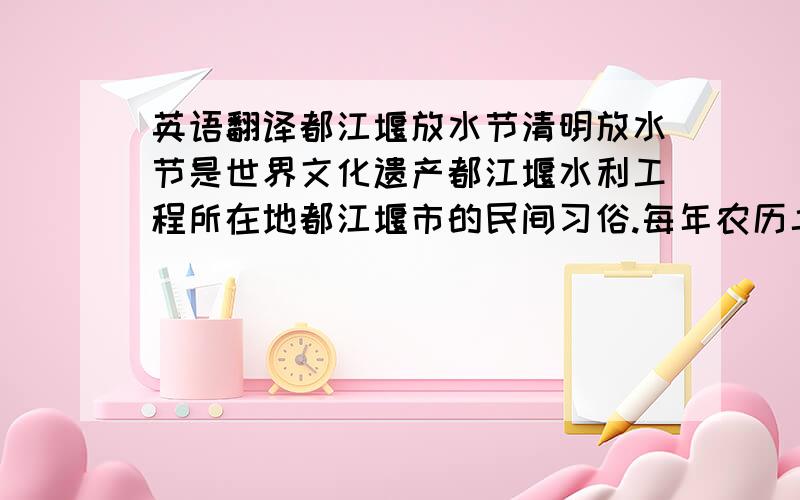英语翻译都江堰放水节清明放水节是世界文化遗产都江堰水利工程所在地都江堰市的民间习俗.每年农历二十四节气的清明这一天,为庆祝都江堰水利工程岁修竣工和进入春耕生产大忙季节,同
来源:学生作业帮助网 编辑:作业帮 时间:2024/04/19 17:59:22

英语翻译都江堰放水节清明放水节是世界文化遗产都江堰水利工程所在地都江堰市的民间习俗.每年农历二十四节气的清明这一天,为庆祝都江堰水利工程岁修竣工和进入春耕生产大忙季节,同
英语翻译
都江堰放水节
清明放水节是世界文化遗产都江堰水利工程所在地都江堰市的民间习俗.每年农历二十四节气的清明这一天,为庆祝都江堰水利工程岁修竣工和进入春耕生产大忙季节,同时也为了纪念李冰,民间都要举行盛大的庆典活动,包括官方祭祀和群众祭祀等.
都江堰市位于四川省中部成都平原西北边沿,地处岷江上游和中游接合部的岷江出山口,公元前256年李冰治理岷江,修筑都江堰水利工程,彻底根治了岷江水患,使成都平原成为"天府之国".
每年农历的清明节在都江堰都要举行隆重的放水大典,以预祝当年农业丰收,这是川西平原源远流长的传统习俗.届时,地方官员要亲自主持放水仪式,举行盛大的庆典活动.
放水节初始于"祀水".那是因为都江堰修筑以前,沿江两岸水患无常,人们饱受水患之苦,为了祈求"水神"的保护,常常沿江"祀水".都江堰修筑成功后,成都平原从此水旱从人,不知饥谨,后人为了纪念伟大的李冰父子,人们将以前"祀水"改为了"祀李冰".当地群众也自发地组织到二王庙祭祀李冰父子,举办二王庙庙会,又称清明会.
每到冬天枯水季节,人们在渠首用特有的"杩槎截流法"筑成临时围堰,维修内江时,拦水入外江,维修外江时,拦水入内江.清明节内江灌溉区需水春灌,便在渠首举行隆重仪式,撤除拦河杩槎,放水入灌渠.这个仪式就叫"开水".唐朝清明节在岷江岸边举行的"春秋设牛戏",就是最早的"放水节".公元978年,北宋政府正式将清明节这一天定为放水节.
旧时,大典通常由四川高级官司员主持.放水前一日,有关人员先到郫县望从祠祭祀望帝、丛帝.放水之日,仪仗队抬着祭品,鼓乐前导,主祭官率众人出玉垒关至二王庙、祭祀李冰父子.随后主祭官朗诵《迎神辞》.众人肃立,唱《纪念歌》.歌毕,献花、献锦、献爵、献食.主祭官读完《祝辞》,与全体祭者向李冰塑像三鞠躬,祈愿一年风调雨顺,五谷丰登,六畜兴旺.然后,砍杩槎放水.杩槎是将三根木棒的顶端都扎在一起构成的三角架,它和签子、捶笆等一起,填土筑堤,可截断流水.主持都一声令下,"咚咚咚"三声礼炮,身强力壮的堰工奋力砍断鱼嘴前阻断内江的杩槎上绑索,河滩上的人群用力拉绳,杩槎解体倒下,江水顷刻奔涌而出.此时,年轻人跟着水流奔跑,并不断用石头向水流的最前端打去,称为"打水头".人们争舀"头水"祭神,认为这样可以消灾祈福,求得神灵庇佑,该俗现仍流行.
清明放水节再现了成都平原农耕文化漫长的历史发展过程和民俗文化,体现了中华民族崇尚先贤、崇德报恩的优秀品质,具有弘扬传统文化的现实意义.
如今,都江堰终年均可放水.但清明节放水的旧制仍是川西人民值得纪念的节日.作为一种古老的文化传统和富有巴蜀特色的旅游观光项目,放水节砍杩槎活动仍每年如期举行
英语翻译都江堰放水节清明放水节是世界文化遗产都江堰水利工程所在地都江堰市的民间习俗.每年农历二十四节气的清明这一天,为庆祝都江堰水利工程岁修竣工和进入春耕生产大忙季节,同
Water Pouring festival
Qingming Festival is a world cultural heritage drain Dujiangyan Irrigation Project located in Dujiangyan city folk customs. Lunar calendar year of the Ching Ming day, to celebrate the completion of Dujiangyan Irrigation Project and maintenance for production into the busy spring season, but also to commemorate Li Bing, a grand celebration to be held in civil society activities, including the official ritual sacrifices and the people and so on.
Dujiangyan City in Sichuan Province, northwest edge of the Central Plain, located in the middle reaches of Minjiang River and pass the joint of the Minjiang River, 256 BC Min Li Bing governance, the construction of Dujiangyan Irrigation Project, complete cure of the Minjiang River flooding, so that the Chengdu Plain a "Land of Abundance" .
Historically, the annual Lunar New Year's festival to be held in Dujiangyan drainage of a grand ceremony to wish a good harvest year, which is long-standing tradition in Western Sichuan Plain. By then, local officials want to turn on the water ceremony, presided over in person, held a grand celebration.
The initial drainage section in the "worship of water." That is because the construction of Dujiangyan before the flooding along the sides of impermanence, the pain of people suffering from floods, in order to pray for the "water god" of protection, often along the "worship of water." Successful construction of Dujiangyan, Chengdu Plain from floods, droughts and from the people, I do not know hunger, and their descendants to commemorate Li Bing and his son great, people will be before "worship the water" changed to "Si Bing." Local people have spontaneously organized the Second Temple worship Li Bing and his son to hold the Second Temple temple, also known as Ching Ming will.
Every winter dry season, people in the headworks with a unique "http Cha Closure Act," into a temporary cofferdam construction, maintenance Neijiang, the stone check into the outer river, maintenance, river, the stone check into Neijiang. Ching Ming Festival Neijiang spring irrigation water requirements in irrigated areas, they held a grand ceremony at the canal head, remove the weir http Croucher, turn on the water into irrigation channels. This ceremony is called "water." Tang Ching Ming Festival in the Minjiang River shore at the "Spring and Autumn Period drama set cow" is the first "rescue section." AD 978, the Song government officially turn on the water that day as the Ching Ming Festival Day.
Old, the ceremony is usually presided over by a member of the Sichuan Higher lawsuit. Turn on the water the day before, the officer first look from the Temple worship Pixian Emperor Wang, Cong Dili. Drainage of the day, honor guard carried the offerings, leading drum, deacon, all the official rate of customs from Temple Yu Lei, Li Bing and his son ritual. Deacon officer then recited "temple speech." Everyone stood and sang "Memorial Song." Bi Song, flowers, Jin Xian, Xian Grand Mercure, offering food. Deacon official reading "Congratulatory Speech", and all those offering three bows to the statue of Li Bing, the pledge year, favorable weather, bumper harvest, domestic animals thrive. Then, cut 杩 Cha water. Http Cha is the top of both sticks and tie the three together to form a tripod, it and sign the child, hammers and other fence together, filling embankment, can cut water. Presided over all the order, "tapping at" three times Salute, able-bodied workers struggling to cut the fish head weir before the http blocking Neijiang tie a rope cha, flood forced the crowd on the ropes, http raft down the disintegration of , river water rushes out of the instant. At this point, young people follow the water running, and continue with stones to fight to the forefront of water, known as "playing head." People fight scoop "first water" ritual, believing it can ward off evil prayer, and seek divine blessing, the customs are still popular.
Plain drainage Qingming Festival reproduce the long history of farming culture and the development of folk culture, reflects the Chinese respect for sages, Zonta gratitude the excellent quality, with a carry forward the traditional culture of practical significance.
Today, Dujiangyan can turn on the water all year round. However, the old drainage system of the Ching Ming Festival is still a memorable holiday in Western people. As an ancient cultural tradition and rich characteristics of the travel and tourism projects Sichuan, turn on the water festival activities are still a year cut 杩 raft held as scheduled